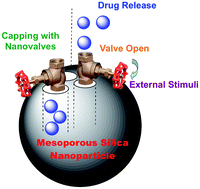This month sees the following articles in MedChemComm that are in the top ten most accessed:
Molecular obesity, potency and other addictions in drug discovery
Michael M. Hann
Med. Chem. Commun., 2011, 2, 349-355
DOI: 10.1039/C1MD00017A
Synthesis and biological evaluation of 2,3-bis(het)aryl-4-azaindole derivatives as protein kinase inhibitors
Frédéric Pin, Frédéric Buron, Fabienne Saab, Lionel Colliandre, Stéphane Bourg, Françoise Schoentgen, Remy Le Guevel, Christiane Guillouzo and Sylvain Routier
Med. Chem. Commun., 2011, 2, 899-903
DOI: 10.1039/C1MD00141H
Design, synthesis, and structure–activity relationships of 1,3,4-oxadiazol-2(3H)-ones as novel FAAH inhibitors
László E. Kiss, Humberto S. Ferreira, Alexandre Beliaev, Leonel Torrão, Maria João Bonifácio and David A. Learmonth
Med. Chem. Commun., 2011, 2, 889-894
DOI: 10.1039/C1MD00136A
Minisci reactions: Versatile CH-functionalizations for medicinal chemists
Matthew A. J. Duncton
Med. Chem. Commun., 2011, Advance Article
DOI: 10.1039/C1MD00134E
Intramolecular hydrogen bonding to improve membrane permeability and absorption in beyond rule of five chemical space
Alexander Alex, David S. Millan, Manuel Perez, Florian Wakenhut and Gavin A. Whitlock
Med. Chem. Commun., 2011, 2, 669-674
DOI: 10.1039/C1MD00093D
Are pyridazines privileged structures?
Camille G. Wermuth
Med. Chem. Commun., 2011, Advance Article
DOI: 10.1039/C1MD00074H
Designing glucokinase activators with reduced hypoglycemia risk: discovery of N,N-dimethyl-5-(2-methyl-6-((5-methylpyrazin-2-yl)-carbamoyl)benzofuran-4-yloxy)pyrimidine-2-carboxamide as a clinical candidate for the treatment of type 2 diabetes
Jeffrey A. Pfefferkorn, Angel Guzman-Perez, Peter J. Oates, John Litchfield, Gary Aspnes, Arindrajit Basak, John Benbow, Martin A. Berliner, Jianwei Bian, Chulho Choi, Kevin Freeman-Cook, Jeffrey W. Corbett, Mary Didiuk, Joshua R. Dunetz, Kevin J. Filipski, William M. Hungerford, Christopher S. Jones, Kapil Karki, Anthony Ling, Jian-Cheng Li, Leena Patel, Christian Perreault, Hud Risley, James Saenz, Wei Song, Meihua Tu, Robert Aiello, Karen Atkinson, Nicole Barucci, David Beebe, Patricia Bourassa, Francis Bourbounais, Anne M. Brodeur, Rena Burbey, Jing Chen, Theresa D’Aquila, David R. Derksen, Nahor Haddish-Berhane, Cong Huang, James Landro, Amanda Lee Lapworth, Margit MacDougall, David Perregaux, John Pettersen, Alan Robertson, Beijing Tan, Judith L. Treadway, Shenping Liu, Xiayang Qiu, John Knafels, Mark Ammirati, Xi Song, Paul DaSilva-Jardine, Spiros Liras, Laurel Sweet and Timothy P. Rolph
Med. Chem. Commun., 2011, Advance Article
DOI: 10.1039/c1md00116g
Development of substituted 7-phenyl-4-aminobenzothieno[3,2-d] pyrimidines as potent LIMK1 inhibitors
Brad E. Sleebs, Danny Ganame, Alla Levit, Ian P. Street, Alison Gregg, Hendrik Falk and Jonathan B. Baell
Med. Chem. Commun., 2011, Advance Article
DOI: 10.1039/C1MD00138H
Redesigning the designer drug ecstasy: non-psychoactive MDMA analogues exhibiting Burkitt’s lymphoma cytotoxicity
Michael N. Gandy, Matthew McIldowie, Katie Lewis, Agata M. Wasik, Danielle Salomonczyk, Keith Wagg, Zak A. Millar, David Tindiglia, Philippe Huot, Tom Johnston, Sherri Thiele, Blake Nguyen, Nicholas M. Barnes, Jonathan M. Brotchie, Mathew T. Martin-Iverson, Joanne Nash, John Gordon and Matthew J. Piggott
Med. Chem. Commun., 2010, 1, 287-293
DOI: 10.1039/C0MD00108B
Identification of 3-aminothieno[2,3-b]pyridine-2-carboxamides and 4-aminobenzothieno[3,2-d]pyrimidines as LIMK1 inhibitors
Brad E. Sleebs, Alla Levit, Ian P. Street, Hendrik Falk, Tim Hammonds, Ai Ching Wong, Mark D. Charles, Michael F. Olson and Jonathan B. Baell
Med. Chem. Commun., 2011, Advance Article
DOI: 10.1039/C1MD00137J
Why not take a look at the articles today and blog your thoughts and comments below.
Fancy submitting an article to MedChemComm? Then why not submit to us today or alternatively email us your suggestions.
Comments Off on Top ten most accessed articles in August











![GA[9]](https://blogs.rsc.org/md/files/2011/10/GA9-300x118.gif)





![CoverIssue[2]](https://blogs.rsc.org/md/files/2011/09/CoverIssue2.gif)